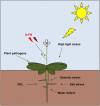TCP Transcription Factors at the Interface between Environmental Challenges and the Plant's Growth Responses
- PMID: 28066483
- PMCID: PMC5174091
- DOI: 10.3389/fpls.2016.01930
TCP Transcription Factors at the Interface between Environmental Challenges and the Plant's Growth Responses
Abstract
Plants are sessile and as such their reactions to environmental challenges differ from those of mobile organisms. Many adaptions involve growth responses and hence, growth regulation is one of the most crucial biological processes for plant survival and fitness. The plant-specific TEOSINTE BRANCHED 1, CYCLOIDEA, PCF1 (TCP) transcription factor family is involved in plant development from cradle to grave, i.e., from seed germination throughout vegetative development until the formation of flowers and fruits. TCP transcription factors have an evolutionary conserved role as regulators in a variety of plant species, including orchids, tomatoes, peas, poplar, cotton, rice and the model plant Arabidopsis. Early TCP research focused on the regulatory functions of TCPs in the development of diverse organs via the cell cycle. Later research uncovered that TCP transcription factors are not static developmental regulators but crucial growth regulators that translate diverse endogenous and environmental signals into growth responses best fitted to ensure plant fitness and health. I will recapitulate the research on TCPs in this review focusing on two topics: the discovery of TCPs and the elucidation of their evolutionarily conserved roles across the plant kingdom, and the variety of signals, both endogenous (circadian clock, plant hormones) and environmental (pathogens, light, nutrients), TCPs respond to in the course of their developmental roles.
Keywords: TCP; development; evolution; plant hormones; signaling; transcription factor.
Figures




References
-
- Andriankaja M. E., Danisman S., Mignolet-Spruyt L. F., Claeys H., Kochanke I., Vermeersch M., et al. (2014). Transcriptional coordination between leaf cell differentiation and chloroplast development established by TCP20 and the subgroup Ib bHLH transcription factors. Plant Mol. Biol. 85 233–245. 10.1007/s11103-014-0180-2 - DOI - PubMed
Publication types
LinkOut - more resources
Full Text Sources
Other Literature Sources

